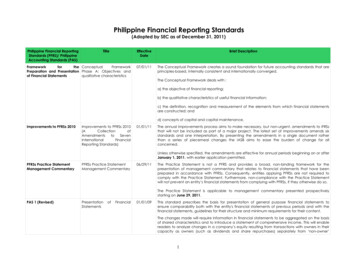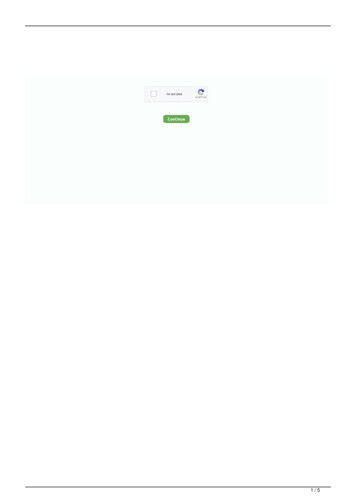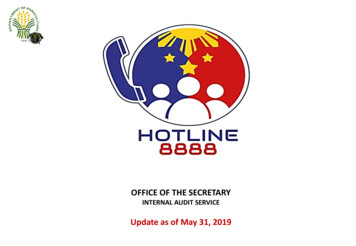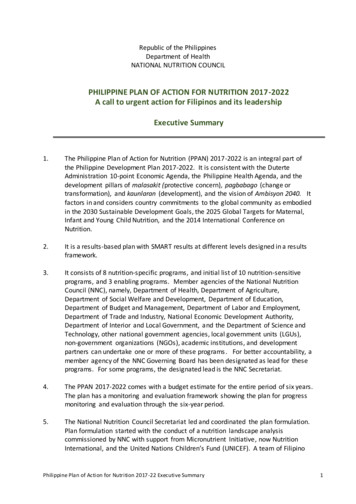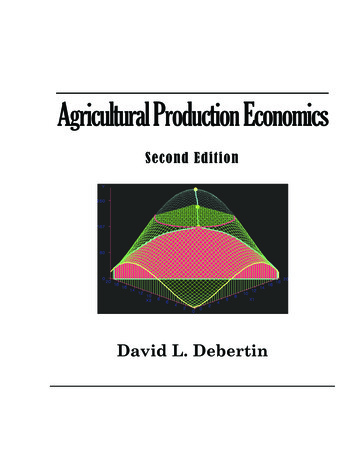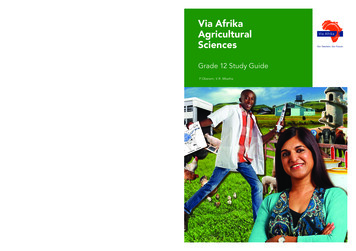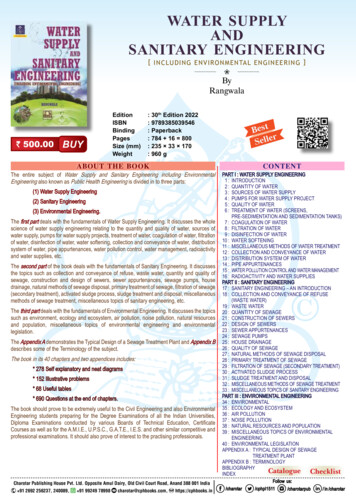
Transcription
PHILIPPINE AGRICULTURAL ENGINEERING STANDARDAgricultural Structures – Housing for Swine ProductionPAES 401:2001ForewordThe formulation of this national standard was initiated by the Agricultural Machinery Testingand Evaluation Center (AMTEC) under the project entitled “Enhancing the Implementationof the AFMA Through Improved Agricultural Engineering Standards” which was funded bythe Bureau of Agricultural Research (BAR) of the Department of Agriculture (DA).This standard has been technically prepared in accordance with PNS 01-4:1998 (ISO/IECDirectives Part 3:1997 – Rules for the Structure and Drafting of International Standards. Itspecifies the general requirements for swine housing.The word “shall” is used to indicate requirements strictly to be followed in order to conformto the standard and from which no deviation is permitted.The word “should” is used to indicate that among several possibilities one is recommended asparticularly suitable, without mentioning or excluding others, or that a certain course ofaction is preferred but not necessarily required.In the formulation of this standard reference were made to:Building Your Farm, Book 5, Basic Pig Keeping Manual, ITCPH, Lipa City.DA AO No. 41, Series of 2000 Code of Practice and Minimum Standards for the Welfare ofPigs.Developing Good Dunging Habits of Swine for Partially Slotted Floors. Farm Structures,May 1982.Esmay, M. L. and Dixon, John E. Environmental Control for Agricultural Buildings.HSUS Recommended Humane Standards for Raising Livestock and Poultry.Jacobson, Larry D. Natural Ventilation for Pig Housing, AEU-5.MacDonald, Ronald Newton and Sue Penman. Pig Husbandry for Warm Climates.Agriculture and Natural Resources Series, UK.Squibb Swine Farming Manual.Structures and Environment Handbook. MWPS, September 1977, 9th Edition.Swine Barn Construction and Services Plan. Canada Plan Service, June 1987.Swine Care Handbook.Swine Housing and Equipment Handbook, MWPS.D-1
Swine Housing and Equipment Plan. Canada Plan Service, April 1986.The Philippines Recommends for Pork Production. PCARRD.Training Manual for Swine Production. SEARCA.D-2
PHILIPPINE AGRICULTURAL ENGINEERING STANDARDPAES 401:2001Agricultural Structures – Housing for Swine Production1ScopeThis standard specifies the minimum requirements for swine housing. It includes spacerequirement, feeding and watering facilities.2ReferenceThe following normative document contains provisions which through reference in this textconstitute provisions of this National Standard:Philippine Electrical Code 2000National Plumbing Code of the PhilippinesPAES 414:20023Agricultural Structures – Waste Management StructuresDefinitionFor the purpose of this standard, the following definitions shall apply:3.1boarrefers to a male breeding swine which is at least 8 months old3.2creep areaplace for piglets inside the farrowing pen3.3culling raterate of removing undesirable or unproductive animals within the herd3.4dry sowsunbred sows which have just been weaned; non-pregnant sows3.5farrowingact of giving birth in swineD-3
PAES 401:20013.6farrowing penarea in which a sow is confined during farrowing and lactation periods, but in which the sowcan turn around3.7farrowing stallfarrowing cratedevice in which a sow is confined during farrowing and lactation periods and which preventssow from turning around3.8fattenerswine raised for meat production usually starts at 15 kg3.9finisherswine which are 66 kg and up3.10giltfemale swine that has not farrowed3.11growerswine from 40 to 65 kg3.12litterpiglets born in one farrowing3.13litter indexfarrowing indexaverage number of farrowings of one sow per year3.14occupancynumber of days an animal stays in a pen3.15sowany breeding female pig that has farrowed3.16weanerweanlingpiglet that has been recently separated from its motherD-4
PAES 401:20014Location4.1The location shall conform to the land use plan of the area.4.2The site shall be accessible to service roads, water supply and electric lines.4.3The site shall be well drained and allows for free air circulation.4.4The building shall be constructed in an east-west orientation and the structure formarketable animals shall be located near the service road.4.5The site shall be located where the prevailing winds will not carry odors to thefarmhouse.5Swine housing system5.1One-unit systemIn this system, the sows are removed when the piglets reach weaning age. The pigs remain inthe same building from farrowing until they reach the desired weight for slaughtering.Gestating houseFarrowing houseSowFigure 1 – One-unit system5.2Two-unit systemThe sows and piglets remain in the farrowing house until the piglets are weaned. Theweanlings are transferred to a growing-finishing house.Gestating houseFarrowing houseSowWeanlingsGrowingFinishing houseFigure 2 – Two-unit system5.3Three-unit systemThe sows and piglets remain in the farrowing house until weaning. The weanlings are movedto a nursery house and finally to a growing-finishing unit where they stay until they are readyfor slaughter.D-5
PAES 401:2001Gestating houseFarrowing houseSowWeanlingsNursery houseGrowingFinishing houseFigure 3 – Three-unit system5.4Four-unit systemThe sows and piglets remain in the farrowing house until weaning. After weaning, piglets aremoved to a nursery house, then to a growing house and finally to a finishing house until theyare ready for slaughter.Gestating houseFarrowing houseSowWeanlingsNursery houseGrowing houseFinishing houseFigure 4 – Four-unit system6Space requirementsMinimum space requirement for swine is shown in Table 1.Table 1 – Minimum recommended space requirement for swineAge and size of animalGroups of growing swineUp to 10 kg11 - 20 kg21 - 40 kg41 - 60 kg61 - 80 kg81 - 100 kgGilts up to matingAdult pigs in groupsD-6Space requirementsper animalm2/animal0.110.200.350.500.700.851.002.50
PAES 401:2001Table 1 (continued)Space requirementsAge and size of animalper animalm2/animalGestating sows1.20Boar pens7.50Lactating sows and litters7.40Individual pens5.60Multi-suckling groupsDry sows1.807Structural requirements7.1Roof7.1.1 Roofing material should be made of corrugated G.I. sheets and other durable roofingmaterials. At least one-meter roof overhang shall be provided to ensure shade and to protectthe swine from rain.7.1.2 Roof should be equipped with gutters so that rainwater can be drained awayseparately.7.1.3 The types of roof for swine housing are semi-monitor, semi-shed, monitor, doublespan and shed as shown in Figure 5.7.2Ceiling (optional)Ceiling height shall be at least 2.4 m high.7.3WallsBuilding sidewalls shall have a minimum height of 1 m and shall be made of durablematerials.7.4Floors7.4.1Solid floors7.4.1.1 Concrete floors shall be paved on a well compacted gravel fills.7.4.1.2 Floor shall be skid-resistant with 2% - 4 % slope towards a gutter or drainage canal.The direction of the slope shall be away from the feeding trough.7.4.2Slotted floors7.4.2.1 Slotted floors should be made of concrete, plastic, metals or combination of suchmaterials. It shall be constructed to allow manure and urine to pass through.NOTE Wood is not recommended as flooring material because it is less durable, difficult to dry hence mayharbor pathogenic organisms, and wood splinters may cause injury to swine.D-7
PAES 401:2001Semi-monitorSemi-shedMonitorDouble spanShedFigure 5 – Types of roof7.4.2.2 . Slotted floors shall be constructed to allow manure and urine to pass through. Therecommended slat width and spacing between slats is given in Table 2.Table 2 – Recommended slat width and spacingSize and type of swineFarrowing sows and piglets(up to 30 kg)WeanersFinishersSows, finishers and boars(over 100 kg)D-8Width of slatmmSlat spacingmm18 - 258-918 - 2560 - 10010 - 1410 - 2080 - 12510 - 25
PAES 401:20017.4.2.3 In partially slotted floors (Figure 6a), the slats shall be placed perpendicular to thelong dimension of pens. For totally slotted floors (Figure 6b), slat should be place parallel tothe sow.SOLID FLOOR AREACONCRETE SLATSaCONCRETE SLATSbFigure 6 – Pens with (a) partially slotted floor; (b) completely slotted floor7.4.2.4 Concrete slats shall be used preferably for swine over 30 kg, including gestating sows.The top finish shall be smooth wood float finish and slat top edges shall be rounded. Refer toTable 3 and Figure 7 for the recommended specification and design of concrete slat.Table 3 – Recommended specification for concrete slatSpanm1.20Slat dimensionsTop widthDepthmmmm102102102152102204Reinforcing barNo. 3 (10 mm)No. 3No. 3D-9
PAES 401:2001Table 3 (continued)Slat dimensionsTop 152102152152152204Spanm1.802.403.0Reinforcing barNo. 4 (12 mm)No. 4No. 4No. 4No. 4No. 4No. 5 (14 mm)No. 5No. 5Top Width19Pencil-roundedgeDepthNo. 2 (6 mm.) bar,can be omitted fromcast-in-place slats.Cover:38 mm. for bars to #5;Bottom Width51 mm. for #6 and(Top width minus 25 mm.)larger bars.Reinforcing barNo. 3 (1cm) for 1.20 m. slatNo. 4 (1.2cm) for 1.20 m.and 2.40 m. slatFigure 7 – Details of concrete slat design7.4.2.5 For swine under 20 kg, flattened expanded metal (20 mm, 9 –11 gauge) shall be used(Figure 8). Supporting joists shall be spaced at 300 mm. Expanded metal shall be treated toprevent corrosion. Sharp edges shall be avoided.7.4.2.6 Welded wire flooring shall be made of 5.3 mm (5 gauge) wire spaced at 12.5 mm, 15mm or 18 mm. It shall be supported every 300 mm.7.4.2.7 Plastic flooring shall be coated with rough surface. Fiberglass reinforced T-slatsshould be used for creep areas in farrowing pens/crates and nursery. Slats shall be 38 mmwide and slots shall be 9 mm. It shall be supported every 600 mm.D-10
PAES 401:20012 c m fla tte n e d e x p a n d e d m e ta lFigure 8 – Expanded metal slotted flooring8Functional Requirements8.1Pens8.1.1Farrowing pens8.1.1.1 Farrowing pens shall be provided with farrowing crates to avoid crushing by the sowFigure 9.Pipe0.300.501.00 m.Solid wall0.500.601.50 m.0.501.80 m.Figure 9 – Typical farrowing crates8.1.1.2 In case rearing pen is used, guardrail should be provided on both sides of the pen. Itshould be fixed 250 mm from the pen wall and 250 mm above the floor.8.1.1.3 The recommended dimension of a farrowing crate is shown in Table 4.D-11
PAES 401:2001Table 4 – Minimum farrowing crate dimensionMeasurementLengthWidth of stallWidth of creepHeight of stallHeight of creep8.1.2Dimensionm1.800.600.501.000.40Pens for weaners/nursery8.1.2.1 Weaners should be either penned in a ground pen or in an elevated nursery cages.These cages shall be provided with slatted floor with slot space clearance of 10 mm – 14 mm.8.1.2.2 It is recommended that the weaners with the same size shall be housed in a pen orcage.8.1.3Growing penSeparate pens for growers should be provided. The size of each pen shall be designed to holdnot more than 25 growers.EXAMPLE8.1.4Growing pen with a dimension of 1.5 m x 4.8 m shall accommodate 20 growers.Finishing penSeparate pens for finishers should be provided. The size of each pen shall be designed to holdnot more than 25 finishers.EXAMPLE8.1.5Finishing pen with a dimension of 1.5 m x 4.8 m shall accommodate 10 finishers.Gestating pen8.1.5.1 Sows should be either housed individually (box/stall) or by group. For individual pen,the dimension should be 0.66 m x 1.8 m.8.1.6Boar pensPen for boars should be located close to the dry sow accommodation. The pen should beprovided with a service crate.8.2Pen partition8.2.1 Pen partitions should be either solid or slotted. The slot shall be within the range of160 mm – 210 mm.8.2.2D-12The minimum height of pen partitions is shown in Table 5.
PAES 401:2001Table 5 – Minimum height of pen partitionSwineUnder 25 kg25 kg – 100 kgSowBoarHeight of pen partitionm0.700.901.001.208.2.3 Fittings and internal surfaces to which the animals have access shall not have sharpedges or projections.8.2.4Surfaces shall not be treated with paints that may cause illness or death.8.3Pen gate8.3.1 Pen gate should be made of at least 10 mm iron bars or at least 30 mm pipe fastenedsecurely to a G.I. pipe frame.8.3.2 The dimension of the gate shall be 600 mm wide and 0.9 m – 1m high. For weanling,a height of 750 mm shall be used.8.4Aisles and WalkwaysPrimary and secondary walkways shall have a minimum width of 1.5 m and 1 m,respectively.8.5Equipment and facilities8.5.1Heaters8.5.1.1 Heaters shall be installed in creep areas to provide newborn pigs its requiredtemperature of 27oC - 35oC until they are 3 days old.8.5.1.2 Heat lamps shall be placed 762 mm above the floor or 152 mm above the sow.8.5.2Feeding facilities8.5.2.1 A properly designed feeding trough shall be provided. Table 5 shows the minimumrecommended length of feeding trough per swine.Table 5 – Minimum recommended length of feeding trough per swineSwine weight15 – 2525 – 5050 – 7575 – 100100 - 130Linear length of troughmm/animal150200250300350D-13
PAES 401:20018.5.2.2 The feeding trough width shall be at least 300 mm and the depth shall be 250 mm.8.5.3Watering facilities8.5.3.1 Water trough or waterers shall not be placed beside the feeding trough to keep feedingarea of the swine dry and clean. The linear space requirement for watering is the same for thespace requirement for feeding.8.5.3.2 Optional watering facilities8.5.3.2.1 For automatic watering cups or bowls, 1 cup/20 weaner, 1cup/12 gilts, and 1cup/10 sows, shall be provided. The bottom rim of the bowl should be 120 mm and 300 mmabove the floor level for weaners and finishers, respectively.8.5.3.2.2 If nozzle type waterers are used it shall be adjustable and it shall be installed at aheight of 450 mm - 650 mm from the floor for sows and growing-finishing pigs and 305 mmfor weanlings. Waterer spacing should be 300 mm apart for nursery pigs, 450 mm forgrowing pigs and 600 mm – 900 mm apart for finishing pigs and group housed gestatingsows.8.5.3.2.3 For nursery, 1 nipple/10 pigs and 1 nipple/12-15 growing-finishing pigs should beinstalled.8.5.3.3 All plumbing design and installation shall conform to the National Plumbing Code ofthe Philippines.8.5.4Lighting8.5.4.1 Artificial lighting shall always be available for use during the night or darkenedperiods of the day.8.5.4.2 Table 6 shows the recommended lighting intensity for swine housing.Table 6 - Recommended lighting intensity for swine housingLighting intensity*Arealux (Lumen/m2)Breeding, gestation and farrowing150Nurseries100Growing and finishing50Inspection areas200*Refer to Annex C.8.5.4.3 All electrical design and installation shall conform to Philippine Electrical Code.8.5.5Ventilation8.5.5.1 Natural ventilation8.5.5.1.1 Outlets should be either ridge or chimney opening on the downwind side of thebuilding, preferably located at the highest point in a building.D-14
PAES 401:20018.5.5.1.2 Inlets should be through vent doors, curtains or other large openings along thelong sides of the building.8.5.5.1.3 If necessary, automatic controls should be provided to maintain the indoortemperature and provide air exchange as weather changes hourly and seasonally. Naturalventilation system controllers should be available to regulate air exchange by adjusting inletand outlet opening sizes. Various devices should be used to adjust the opening size:pneumatic systems; either manual or motorized cable and winch systems; and motorizedmechanical arms.8.5.5.2 Mechanical ventilation (if necessary)8.5.5.2.1 Mechanical ventilation (e.g. fan) should be provided to deliver the required airflow rate (Table 7).Table 7 – Minimum ventilation rates under normal conditionSTAGEFarrowing unit (sow and litter)Nursery pensGrowing-finishing pensBreeding and gestating pens(gilts, sows and boars)8.5.5.2.28.5.6Ventilation ratem3/min0.280.080.120.28Fans should be installed on the side opposite to the prevailing winds.Temperature8.5.6.1 The recommended maximum temperature that shall be maintained is shown inTable 8.Table 8 – Maximum temperature for housed swine in still airTemperatureClassoCSows and boars30Piglets newborn353 weeks30Weaners30Growers and Finishers308.5.6.2 Optional facilityWater spray nozzles should be provided to provide cooling effect. Nozzles should be placedapproximately 1.8 m above the floor and pointing straight down to obtain the best pattern andcover the width of the pen.D-15
PAES 401:20019Storage for feeds and supplies9.1A well-ventilated area should be provided for feed storages. It should be providedwith mesh wire.9.2The space required should be based on two weeks supply of feeds.10Waste disposalFor waste management, refer to PAES 414:2002 Agricultural Structures – WasteManagement Structures.D-16
PAES 401:2001Annex A(informative)Computation of the number of pensA.1Formula for the computation of period of occupancy/penA.1.1 Farrowing/Rearing Pen-FRP (in days)acclimatization period of sow .lactation period cleaning and disinfection .Total period of occupancy 728-35338-45A.1.2 Nursery/Weaners’ Pen (in days)rearing period (weaning up to transfer to fatteningpen) cleaning and disinfection .Total period of occupancy 30-35333-38A.1.3 Fattening Pens (in days)fattening period . cleaning and disinfection .Total period of occupancy 90-150393-153A.1.4 Dry and Pregnant Pens365 – (occupancy in FRP x Litter Index)A.1.5 Gilts Pen (selection at 6 months)rearing period . cleaning and disinfection .Total period of occupancy 60363A.1.6 Boar’s Pen (selection at 6 months)rearing period (2 months) cleaning and disinfection .Total period of occupancy 60363D-17
PAES 401:2001A.2Formula for the computation of the number of pensA.2.1 Farrowing/Rearing Pens No. of Sows x Litter Index x Occupancy Period 1.1365A.2.2 Nursery/Weaners Pens No. of Sows x Litter Index x Weaned/Litter x Occupancy 1.1365 x No. of Piglets/PenA.2.3 Fattening Pens (No. of Sows x Litter Index x Reared/Litter - Gilts and Boars raised as replacement )x Occupancy x %Retained for Fattening365 x No. of Fatteners/PenA.2.4 Dry and Pregnant Sows Pens A.2.5 Gilt Places A.2.6 Boar Pens D-18No. of Sows x Occupancy Period 1.1365No. of Sows x Culling Rate x Occupancy Period 1.1365 x Selection RateNumber of SowsBoar to Sow Ratio
PAES 401:2001Annex B(informative)Sample of a 24-sow level fattener productionD-19
PAES 401:2001Annex C(informative)Lighting 940W1.9891.5911.1930.7960.5970.3980.1990.040No. of Bulbs Required per m2Incandescent .0310.0230.0210.0100.0060.005Fluorescent 0.2050.0800.1360.0530.0680.0270.0140.005
PAES 401:2001 4 Location 4.1 The location shall conform to the land use plan of the area. 4.2 The site shall be accessible to service roads, water supply and electric lines. 4.3 The site shall be well drained and allows for free air circulation. 4.4 The building shall be constructed in an east-west orientation and the structure for marketable animals shall be located near the service road.

